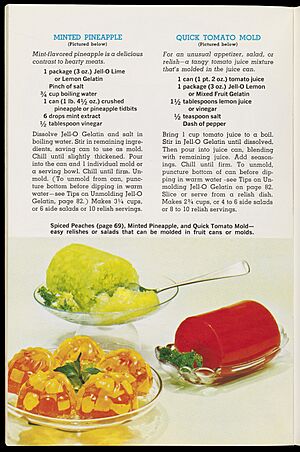Recipe facts for kids
A recipe is a set of instructions that tells you how to make something, usually a food dish. Recipes help you create tasty meals and treats step-by-step.
Today, most recipes include several important parts:
- The name of the food you are making
- How much time it will take to prepare and cook the food
- The ingredients you need and how much of each
- The kitchen tools or equipment you will use
- A list of steps to follow to make the food
- How many people the recipe will feed (this is called the "yield")
Older recipes often had much less information. They might just remind someone of the ingredients needed, assuming the cook already knew the steps.
Contents
The History of Recipes
Early Recipes from Ancient Times
The very first known recipes come from around 1600 BC. They were found on a clay tablet written in the Akkadian language from ancient Babylonia.
The ancient Egyptians also showed how they prepared food. They used hieroglyphics, which are picture writings, to record their cooking methods. Many recipes are also known from ancient Greece. A cook named Mithaecus wrote an early cookbook, but most of it is now lost.
Later, Roman recipes appeared, starting around the 2nd century BC. Authors like Cato the Elder wrote about cooking. Many writers from this time also explained cooking from the eastern Mediterranean region in both Greek and Latin.
Recipes in the Middle Ages
In England, King Richard II asked for a recipe book to be made in 1390. It was called "Forme of Cury." Around the same time, another book, "Curye on Inglish," was published. Both books show us how noble families in England prepared and served food back then.
By the 1400s, handwritten books called manuscripts started to appear. These books often gave good details about recipes. They also recorded the re-discovery of many herbs and spices. These included coriander, parsley, basil, and rosemary. Many of these spices had been brought back from the Crusades, which were religious wars.
During the 1500s and 1600s, printed books became more common. Wealthy families competed to have the best food. Books were written to teach people how to manage their households and prepare meals. In places like Holland and England, noble families tried to make the most amazing foods.
By the 1660s, cooks began to publish their own recipe books. They wanted to show off their skills and compete with other cooks. Many of these old books have now been translated and can be found online.
Recipes from the 1800s to Today
Famous French Chefs
In Europe, French chefs had a huge impact on cooking. They developed what is known as haute cuisine, which means "high cooking." Other countries copied their fancy cooking styles. Great innovators included La Varenne (1615–1678), Carême (1784–1833), and Escoffier (1846–1935).
Modern Cooks and Media Influence
By the 1800s, cooking became a popular hobby around the world. Mrs Beeton (1836–1865) was a famous English writer. She published her well-known "Book of Household Management" in parts between 1857 and 1861. This book used new technology and publishing ideas. Around the same time, American cook Fannie Farmer (1857–1915) focused on cooking. She published "The Boston Cooking School Cookbook" in 1896, which had 1849 recipes!
The next big change came with "media cooks." These were cooks who shared recipes through radio, newspapers, and books. Philip Harben was one of the first on British radio and television. Later, Fanny Craddock also became famous on TV.
TV cooking shows brought recipes to many new people. These viewers wanted to try new ways of cooking. At first, you could get recipes by mail from the BBC. Later, systems like CEEFAX and ORACLE showed recipes on your TV screen. Today, television is still a major source for recipes. Famous cooks and chefs like Julia Child, Jamie Oliver, Nigella Lawson, and Rachael Ray have TV shows and websites. They share all the details of their recipes with people worldwide.
Images for kids
-
A recipe in a cookbook for pancakes with the prepared ingredients
-
Fredrika Runeberg's original recipe from 1850s for "Runebergsbakelse"
-
A page from the Nimatnama-i-Nasiruddin-Shahi, a book of delicacies and recipes. It shows how to make kheer.
-
Medieval Indian Manuscript (circa 16th century) showing samosas being served.
See also
 In Spanish: Receta culinaria para niños
In Spanish: Receta culinaria para niños











